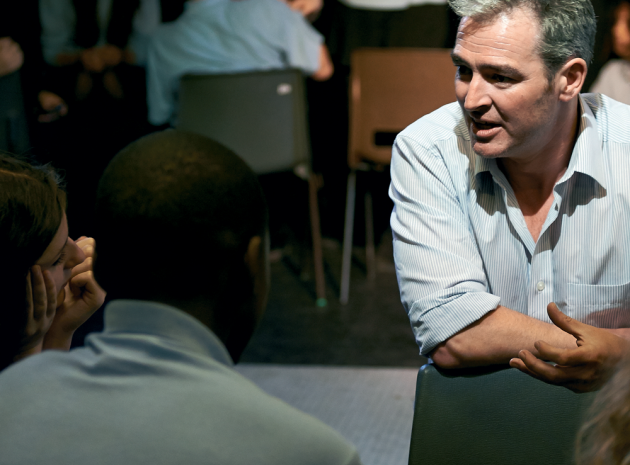As we approach the bard’s 450th birthday celebrations, Jerome Monahan looks at the importance of introducing students to the playwright’s practical side…
It may not be conclusive, but when you have stood at the Globe on a damp day to watch a performance of The Tempest and heard the tears of ‘the good old lord Gonzalo’ described by Ariel as running ‘down his beard, like Winter’s drops/From eaves of reeds’ - only to see rain droplets falling in just this manner off the thatch over the galleries, it seems incontrovertible that this and other plays could only have been written by someone steeped in the theatre of his day.
We know that Shakespeare was an actor. His name appears as such in court records and in cast lists, and when the writer and university man Robert Greene went for him in 1592 in his Groatsworth of Wit, his criticisms fastened on Shakespeare’s being a ‘player’ - supposing ‘he is as well able to bombast out a blank verse as the best of you’. Less reliable evidence of the playwright’s acting pedigree comes via Nicholas Rowe (1674-1718), the first modern editor of his works, who claimed he was a specialist in old men parts such as Adam in As You Like It and the ghost of Hamlet’s father.
One of the main challenges facing anyone teaching Shakespeare is to provide students with a sense of the plays being enacted, so lifting the events off the page and enabling them to imagine the characters in three-dimensions, relating to one another ‘in space’. Understanding, and reminding learners, that these works were written to be performed by a performer, can help enormously.
It is considered a higher order skill for students to be able to discuss the plays ‘in performance’ like this, but there is an additional dimension that also needs to be appreciated, and that is the extent to which the actual public playhouse settings in which Shakespeare’s plays were presented are highly influential when it comes to their content. Shakespeare, actor and playwright, wrote plays that were superbly practical; adapted to the precise demands and possibilities of the early modern theatrical spaces for which they were created.
Beyond the boards
It is perhaps unsurprising how much Shakespeare borrows images and metaphors from the theatre, but students need to be sensitive to this tendency and also how extraordinary it really is. It is often said that the one thing that makes soap operas like East Enders unrealistic is the fact that no-one ever refers to the plots of TV serial dramas in their conversations. The same cannot be said of Shakespeare’s characters – for example Fabian in Twelfth Night, who, on witnessing a plot against the officious Malvolio going to plan, proclaims: “If this were played upon a stage now, I could condemn it as an improbable fiction.”
Such references to the theatrical conventions and construction of events in a play are defined as ‘metatheatrical’ – a catch-all term encompassing all sorts of fascinating and complex occasions and first coined by literary critic Lionel Abel in 1961. He may not have known the word, but Shakespeare was a master of the metatheatrical, employing it to achieve all sorts of effects – even, as in the case of Fabian’s words above, using it as a kind of credulity-restorative at a point in a play when events may have seemed quite improbable. Shakespeare’s most elaborate metatheatrical speeches are particularly associated with melancholic characters for whom the perception of the world as essentially illusory or made up of performance or role-playing suits their disillusionment. Jaques’ ‘Seven Ages of Man’ speech from Act II Scene 7 in As You Like It is a perfect example and one that is heaven-sent for an enjoyable opening activity. I often read this speech with a class and then give them in pairs or threes the task of creating a ‘human sculpture’ encompassing as many ingredients as they can from the speech attributed to a single ‘age’. As each tableau is presented, I invite another student to act as interpreter, identifying all the elements it contains drawn from the original speech. This reinforcement is helpful in embedding the language; done well, and you’ll have students recalling the absurdity of a soldier “seeking the bubble reputation even in the cannon’s mouth,” months after the lesson has ended. I follow up this work with a discussion of what might occasion such an outlook and how strange it is to have a character making reference to something that draws attention to the illusory nature of what is unfolding on the stage itself. To what extent such speeches enhance or detract from the verisimilitude of such early modern dramas is a fascinating debate.
Then and now
The remarkable 1596 Johannes de Witt/Arend van Buschell sketch of the Swan Theatre [fig 1.] is the only extant contemporary picture of the interior of an Elizabethan playhouse, and as such, it provides the ideal prompt for a discussion and cataloguing of the differences between such a playhouse setting and a modern conventional theatre – indoors; artificially lit; viewed from a single perspective as if through an invisible ‘fourth wall’. The key departure that needs highlighting is the exceptional possibilities that playhouse day-time performances offered actors for interacting directly with audiences – especially those at their feet, standing in the yard.
This can best be conveyed by getting students to act out a short scene, such as the Witches’ opening speeches at the start of Macbeth. I establish from the beginning the fact that they will be having to engage with an audience that is literally on all sides of them – and even behind them, given the presence of the Lords’ Gallery, where seats cost 6d. Many students will doubtless fall into the trap of turning their backs to the audience and performing a kind of intimate, TV-inspired scene in the middle of the acting area. It is wonderful turning them around, and inviting them to share anything they can with the maximum numbers of audience members. Not only do students start to realise the value of such things as contrasts or lists of images that can be divided up and directed to different points in the playhouse, but they will start to feel the power they have to shock an audience by directing a call to a familiar spirit: “I come Greymalkin”; into their midst (if it makes students jump now, the frisson there may have been in 1606 among groundlings for whom witches and the demonic were very real fears can only be imagined…)
This exercise can be followed up by students considering another extraordinary scene in the same play, when Lady Macduff and her son are murdered (Act IV Scene 2). Terms that will be helpful here are ‘locus’ and ‘platea’ – derived from Medieval theatre and yet still highly relevant to the work of Shakespeare and other early modern playwrights. The challenge to students is to map this brief scene; identifying those elements of it which are firmly the stuff of the play’s main narrative and which belong therefore to the ‘locus’ portion of the stage where stories are enacted, and those bits that invite interaction with the audience, with a character almost stepping briefly out of the tale to engage in discussion with the audience in a front-stage ‘platea’ position:
“But I remember now
I am in this earthly world; where to do harm
Is often laudable, to do good sometime
Accounted dangerous folly: why then, alas,
Do I put up that womanly defence,
To say I have done no harm?. “
It is this dynamic that is always at work in Shakespeare’s plays, and studying who it is that has this right on occasion to step into the platea and so interact with the audience is both fascinating and rich.
An interesting follow up is to challenge students to research the novel theatrical possibilities that arose when Shakespeare’s company increasingly enjoyed the privilege of invitations to court and finally gained an indoor playhouse setting after 1608 with the Blackfriars Theatre [fig 2.]. In these more intimate settings, lighting and other effects could be controlled – and therefore far more elaborate.
I like to set students the task of considering how this new environment may have enabled the masque in Act IV scene 1 of the Tempest, with its descending classical gods and elaborate scenes involving ‘rich leas/ Of wheat, rye, barley, vetches, oats and pease’; ‘turfy mountains, where live nibbling sheep’, ‘flat meads thatch’d with stover’, and ‘broom – groves/Whose shadow the dismissed bachelor loves, Being lass-lorn’ (and this just in the first speech of the play within the play!) and coming up with one or more illusory scene ‘flats’ upon which these and other images might have been depicted, and which could now be deployed.
Three more great ways to bring Shakespeare to life for students
From comic book interpretations to live participation…
Comic possibilities
The rewritten national curriculum requires all pupils between the ages of 11 and 14 in England’s state schools to study at least two of Shakespeare’s plays in full, from September. A daunting task perhaps – but help is at hand. Designed to encourage literacy, Classical Comics has produced visually stimulating Interactive Motion Comics to get pupils excited about Shakespeare’s plays and to enable them to engage with his work in a unique way.
See an online demonstration at classicalcomics.com/ interactivedemo or visit Stand L40 at the Education Show (20-22 March, NEC Birmingham) to discover the many benefits of using Interactive Motion Comics in the classroom. (classicalcomics.com, 0845 812 3000, info@classicalcomics.com)
Beating the barrier
Are your students struggling with Shakespeare? Their faces blank with sheer incomprehension? The Shakespeare Comic Book Series offers edited versions of the Bard’s plays in comic book format – along with a modern English translation. It makes Shakespeare accessible, but not dumbed down. All the key speeches have been retained and the dual text makes the toughest language digestible.
Suitable for work at KSS 3 and 4, titles include Macbeth, Romeo and Juliet, The Tempest, A Midsummer Night’s Dream, Twelfth Night and Henry V. Teachers’ Books and discount available. (shakespearecomics.com, Shakespeare Comic books: 01691 770165, Shakespeare Comics distributor: 01743 454881)
Get involved
Shakespeare Schools Festival trains and supports teachers to direct their own abridged Shakespeare play to be performed on a professional stage. For the young people who take part it improves literacy, boosts confidence and raises aspirations, as well as giving them a unique opportunity to interact with other schools in their community. Participation also presents a good opportunity to bring Shakespeare on the GCSE curriculum to life, whilst developing a life-long love for learning and cultural heritage.
Do something amazing. Challenge, support and inspire your students as they perform Shakespeare on a professional stage. (www.ssf.uk.com, 0207 601 1826, enquiries@ssf.uk.com)











It is often said that the one thing that make soap operas like eastenders unrealistic is the fact that no-one ever refers to the plots of tv serial dramas in their conversations. the same cannot…